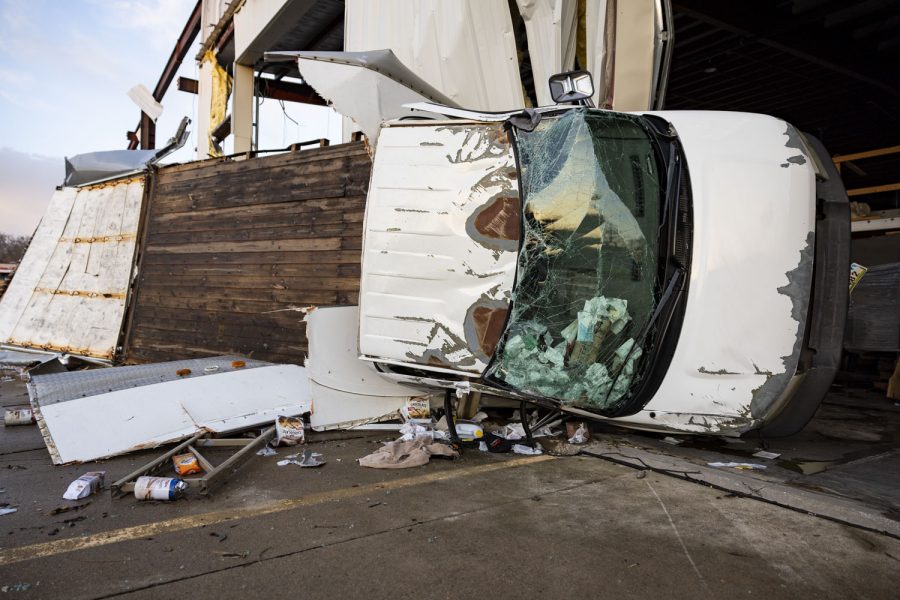Johnson County working to assist residents after tornadoes in March
After being hit by tornadoes and severe weather in late March, the county was able to respond quickly by setting up resources for county residents to take advantage of.
A truck sits on its side after a tornado went through parts of Coralville on Friday, March 31, 2023. The Coralville fire and police departments worked alongside other agencies to help facilitate cleanup.
April 6, 2023
After several tornadoes swept through Iowa on March 31, Johnson County has been quick to mobilize and respond to the damage.
The storms caused heavy damage in parts of Solon, Hills, and Coralville and left 2,000 residents in the area without power. The Johnson County Emergency Management Agency conducted the response effort, said Johnson County Board of Supervisors Chair Lisa Green-Douglass.
She said the agency and the county started preparing for the storm March 28 after receiving reports indicating that the severe weather was coming.
RELATED: Iowa City continues flood mitigation nearly two decades after the last major flood
“Just knowing that it was coming already and thinking about what might need to be in place was really helpful to know that far in advance,” Green-Douglass said. “With some storms, you don’t have that kind of advance warning, but this one we did.”
Johnson County opened its Emergency Response Fund on April 1 in response to the severe weather. Emergency Response Fund Grants are available to support local nonprofit organizations, schools, and units of government that support the immediate and emergent needs of those impacted by the severe weather.
Leading the response was Johnson County Emergency Management Agency’s Director Dave Wilson. Wilson said the county utilized the Joint Emergency Communication Center, which acts as a support agency for local municipalities and directs police, ambulance, firefighters, and others to where it’s most needed.
The coordinated efforts also meant that any affected utility services could be restored quickly. Supervisor Jon Green said he lives 10 miles south of Iowa City in a more rural area that was hit by the storms and lost power.
Green said it was only out for about two and a half hours before being restored.
Wilson also said shelters could be set up if people were displaced. During the storm, several of these shelters were opened throughout the county. One shelter was opened in Coralville for 11 residents to take cover during the storm.
These shelters were also available on Tuesday, when more severe weather was expected, and closed the following day.
While the storms have now passed, the next step will be recovery.
The county website was updated on Wednesday to include a tornado relief guide that residents can access. Coming in several languages, the guide features six steps for residents to take.
The first step, and one that Wilson said should be done as soon as possible, is to report to the county any property damage sustained. He said that a damage assessment is underway and that it’s important for residents to report at the earliest opportunity so the assessment can be completed sooner.
Wilson estimated the assessment to be completed in a week but said it was highly dependent on when residents reported damage.
“There’s a process to each record, so the more of them there are, the longer it takes, and then the slower people are at not reporting it to our system, the slower it is,” Wilson said. “So if you’re just now reporting it today, on day six, you’re already five days behind.”
Steps two through five involve contacting personal insurance, such as Hawkeye Area, Community Action Program, the Red Cross Foundation, and Johnson County Social Services General Assistance.
Wilson said residents could complete steps one through five simultaneously.
The last step in the process involves contacting United Way of Johnson and Washington Counties, which is a privately funded charity, as a safety net for residents. He said residents would be referred to United Way, and they should not contact United Way unless no other group could help them.
For now, Wilson said the goal is to help people recover as best as possible.
“The biggest thing we want people to know is everybody’s goal is the same, right? To give people back up. You might not make them whole again, but we want them to be safe and stable and help them recover,” he said. “We’re here to help you get back on your feet and fill as many gaps as we possibly can.”



